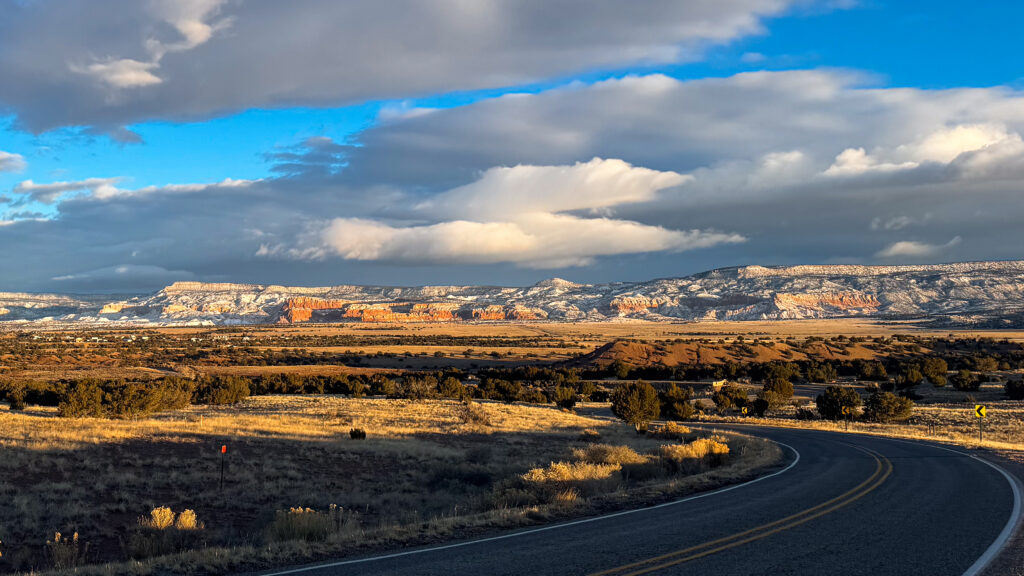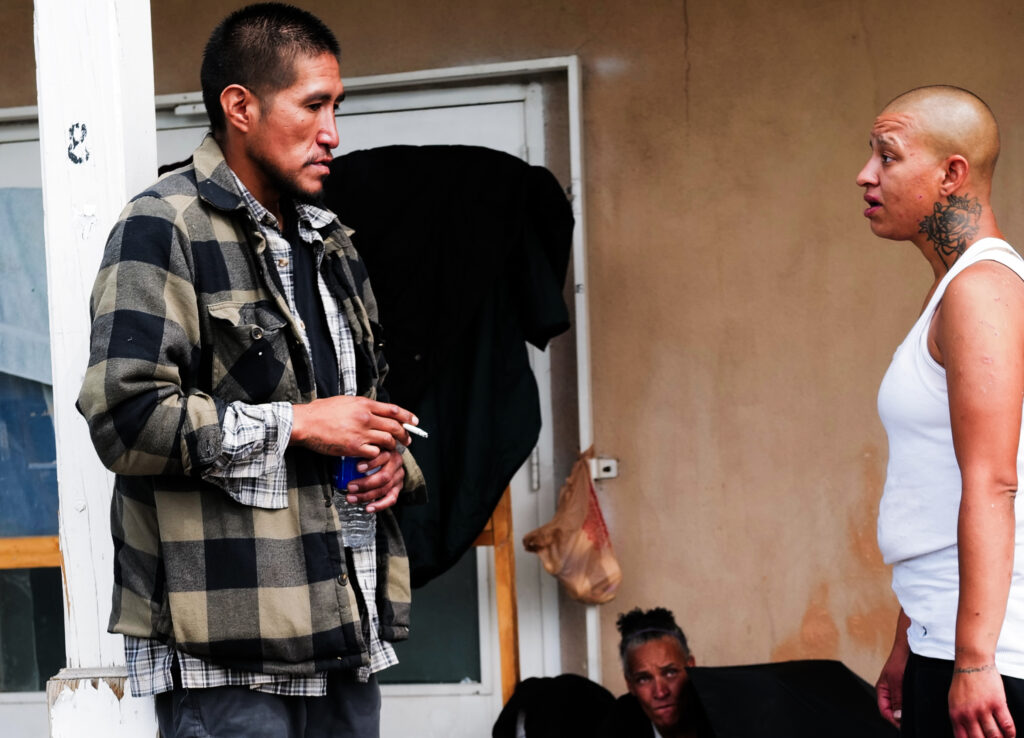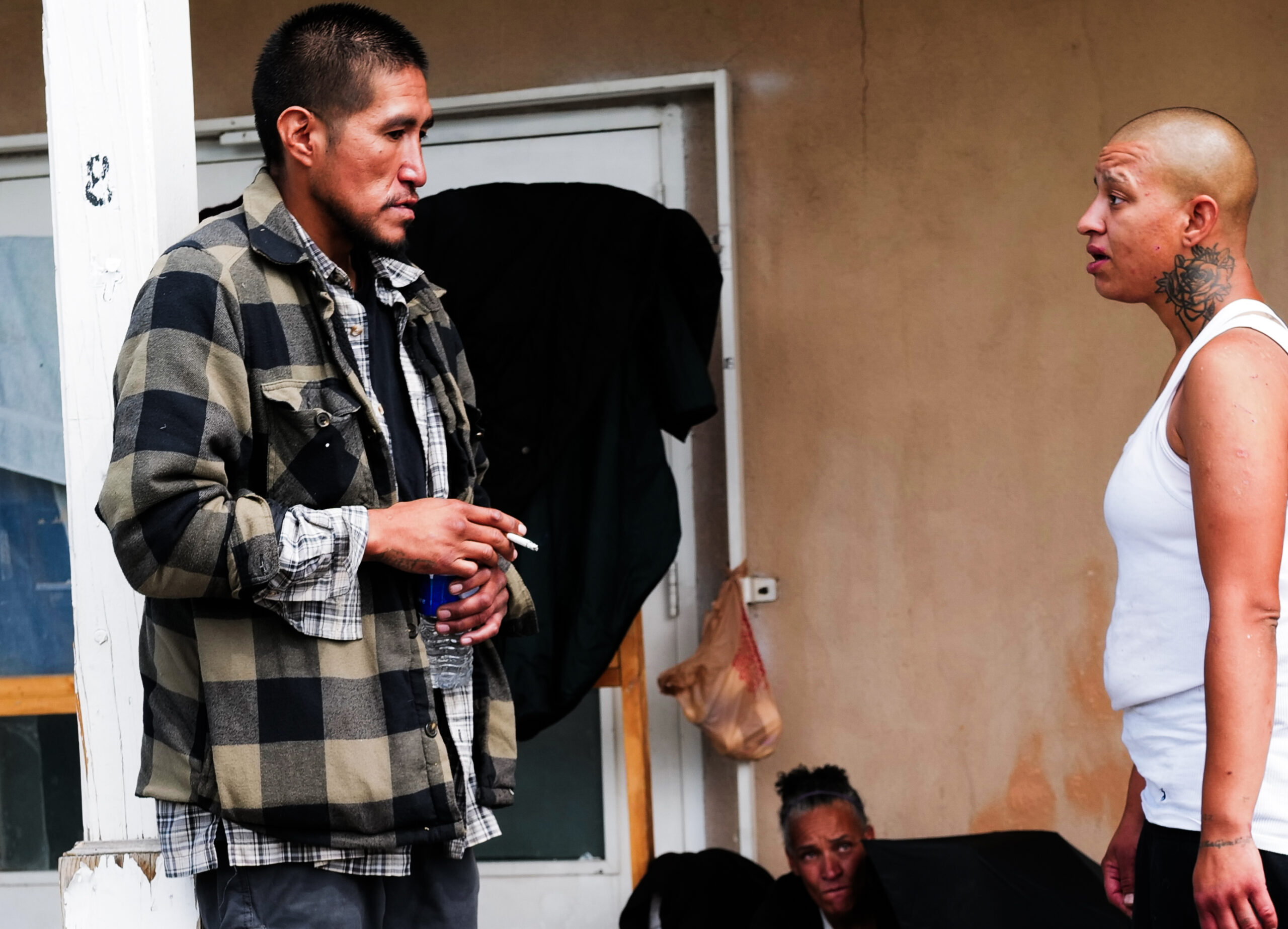by Paul Martin
Luis is generously tatted. Faded green-gray flames creep up his neck onto his sun-hardened face. I’m riding shotgun in the cab of his flatbed en route to Albuquerque after I woke to find my rental car totaled by an overnight hit-and-run. The sun sears through a spiderweb-cracked windshield. I am hot and wondering what I am doing here again, a thousand miles from home.
I push through with small talk—tell Luis about my awe of Northern New Mexico. The natural beauty. The art. The history. Oppenheimer.
“Yeah, Santa Fe is a great city.”
“So is Española,” I reply.
He darts over a disbelieving grin. “You serious, man?”
I share that I’m subbing at the high school.
“Those kids got it hard. Trust me. What do you tell ’em? “
“I try to listen.”.
He nods. “It’s F-ed up. And fentanyl’s a bitch.”
Then he tells me about Ava, the 13-year-old daughter of a fentanyl addict living with his family.
“My wife said we had to help. Her mom switched from heroin to fentanyl. Became a ‘zombie.’ When we found Ava, she lived on the streets, skinny with lice all over her body. The hard part is that she’s been with us for six months. Social workers don’t call back. We don’t have room for her because I have three kids. Money’s tight. And we can’t enroll her in school. They say you gotta have a guardian.”
Luis unloads my car from the flatbed. It’s Hertz’s problem now. I approach him and look into his eyes, “You realize the average age for girls to be sex trafficked is 12. Right? Predators see them coming. They see their vulnerability. They flatter them. Buy them clothes. Ease them into it.”
“You saved her, Luis. Can I have your number? I want to help. She needs to be in school. She needs a home.”

Española is halfway between one of the world’s fine arts capitals, Santa Fe, and where I spent much of 2023—Abiquiu, a region that inspired artist Georgia O’Keeffe to leave New York City and spend decades reproducing its wild and breathtaking landscape. She said, “I’d never seen anything like it before, but it fitted to me exactly. It’s something that’s in the air, it’s different. The sky is different, the wind is different.”
Passing through Española on the way to the Santa Fe Airport, I wondered dozens of times, What’s going on here? Retail stores abandoned, windows layered with plywood, an ominous stucco liquor store, Saints and Sinners—steel security mesh covering the windows. Destitute-looking wanders dancing alone. A “baby box” at the fire station takes in unwanted infants.
I’ve led initiatives in cities where the systemic cocktail of generational trauma, poverty, and narcotics reign: The Bronx, Memphis, Ferguson, Oakland, Chicago, South Central. I had seen nothing like this. Recently, Hollywood and my local newspaper had also zeroed in on the realities of Española. The town was the setting of an upcoming TV series, The Curse, with Emma Stone and Nathan Fielder, and an LA Times article published in March titled, “Can this town save itself from fentanyl addiction? The race to turn around a threatened community.”

Fentanyl is up to 50 times stronger than heroin and just as addictive. Dirt cheap to make—fifteen pounds fits into an average-sized backpack, enough to kill 15 million people. It is now the leading cause of death for Americans between 18 and 45. The DEA deems it “The greatest drug threat our country has ever faced.”
After securing chemicals from China, cartels “cut” fentanyl into benign powders to make counterfeit pills, providing an opioid-like high for a fraction of the cost. So it’s not just the fentanyl addicts among the approximately 80,000 killed in 2022—it’s also the unsuspecting that thought they were trying a Xanax, or Oxy, or Adderall for the first time. Many of them were teens who found it via a dealer on Snapchat. These ones didn’t “overdose.” They were poisoned.
Traditional fatalities from narcotics are usually a result of needing to increase the dosage to achieve the same high—diminishing returns, some say. This is how Prince, Heath Ledger, and Tom Petty died; they were playing with fire and knew it. But with fentanyl, plenty of users die while experimenting for the very first time.
And supply is plentiful. In 2023, 76 million fentanyl pills and 12,000 pounds of fentanyl powder were ceased in the U.S. This is enough to kill over 380 million. With China’s and Mexico’s unrelenting efforts to continue the flow—coupled with aggressive dealers—some believe fentanyl should be deemed a weapon of mass destruction.
Trying to understand the fallout from fentanyl in Española, I started with the numbers. Federal data from two decades ago shows Rio Arriba County ranking first in drug fatalities in New Mexico, with a death rate of 42.5 per 100,000, compared with a national average of 7.3. In 2022, the overdose rate is the highest in the state, which ranks amongst the highest in the nation.
But data only takes you so far. Phone calls or Zoom can’t compete with moving your body to the place. You read body language, intuit tone of voice and unsolicited narratives.
I drove down to Española and applied for a substitute teaching credential. A few weeks later, I stood in sophomore English class—with the kids I had been warned about. Yes, most lived well below the poverty line. And all lived with the specter of a substance use disorder, many losing family and friends. But I was the oddity. When I shared that I was from California, was a UCLA grad, a consultant, and that I traveled for work, they had good reason to wonder about me.
“Why are you here? Doing this? This place sucks.” One senior quipped, “This is a hobo town.”
I also began consulting leaders of the city’s only shelter. I always made sure to sit outside and talk with those addicted. All reported switching from heroin because of low cost, accessibility, and especially “how hard and strong it hits.”
The depiction of those working in the trenches spoke volumes.
“Over the last two years, the landscape of addiction has changed,” Cristian Madrid, Executive Director of Española Pathways Shelter, explained. “We have seen in real-time biophysical and psychological changes in behaviors and actions stemming directly from the use of fentanyl. We have seen over 95% of our clients switch to fentanyl as their primary substance of choice.”
At a meeting with city leaders, a veteran social worker sighed and sat at the end of the makeshift conference table. With her head in her hands, she just stared down.
“We long for the days of heroin.”

The day after Luis told me about Ava, I met with a public school administrator. I shared Ava’s story. “Welcome to New Mexico,” she said with a chuckle of indifference. She directed me to a website that “might help.”
I call the number on the contact page. It goes to voicemail. I send an email.
Back at the shelter, a photojournalist has flown in. Jonathan Alpeyrie had read the Times article. He’s covered conflict zone assignments worldwide and was held hostage by Syrian rebels. He’s recently been in Ecuador, El Salvador, and Mexico—where fentanyl is made. Now he’s in Española to cover where it’s used.
We are meeting with the Executive Team. I share the story of Ava to underscore fentanyl’s indirect effects, primarily on youth.
The Program Director, Maya, interrupts. “Wait. Wait. I can help! Where is she now?”
She explains being homeless at 12 and how she worked her way through the system. She is now 23 and a social worker. She has connections.
My phone rings while she’s mid-sentence. It’s the agency I contacted on Monday. I motion for Maya to join me down the hall. I hit speakerphone. Arrangements are made to enroll Ava in a school immediately.
I call Luis and tell him the good news. Maya suggests we all meet in person.
The next day, we all sat at a local park picnic table. Maya and I are on one side, Luis and his wife are on the other, along with Ava.
I’m nervous. This isn’t a board meeting or a gala. I’m face to face with the fallout from this insidious drug—no father, poverty, living on the streets, an addicted mom who abandoned her in March due to fentanyl.
Maya asks with calm empathy, “How are you feeling, Ava?”
She darts glances at each of us, pauses, and gently shakes her head with eyes fixed downward. “I’m confused, I guess. But I know things will get better.”
I tell her that help has come, she’s not alone, and we are getting her a phone—her phone so she can call the agency or Maya if she needs to.
She blushes and whispers, “I can’t believe this is happening.”
I fly home to California on Saturday.
Monday. I text Luis. Nothing.
Tuesday. I still haven’t heard the news. Just after noon, I receive a text from Maya. “She’s enrolled! I’m working with several agencies to figure out her housing situation.”
Thursday. I fly to DC. Jonathan has invited me to meet parents who have lost their children to fentanyl. There’s a gathering on the National Mall on Saturday.
Friday. I finish a meeting in Arlington. In the Uber, I text Luis to check in:
“Just checking in on Ava. How are things?”
His immediate response was, “Well, that’s not good. She ran away Wednesday night. We reported it. The police haven’t heard anything.”
Saturday. Hurricane Ophelia has moved up the coast. I arrive at the Washington Monument to take part in the event called “Lost Voices of Fentanyl.” Hundreds of parents soldier through the wind and rain, carrying posters with the faces of their deceased children. I speak with dozens, noticeably enduring stages of grief: anger, depression, and bargaining. Many share how their child thought they were taking a harmless pill. But the pill had been cut with fentanyl.

I’m invited to a dinner. Later, I’m sitting with six parents whose children overdosed and died. A woman from Tennessee reaches across the table and hands me her iPhone. It’s playing a local news video of her deceased son’s story. He took a fake pill. Tears stream down my face. She walks around the table to hug me as she weeps.
I’m thinking of her pain.
And I’m thinking of a missing girl in New Mexico.
I’m back again in December. I’m thinking of the contrast between addicts roaming the streets like Ava’s mother and all the innocent youth – the collateral damage. I pitch an idea for a leadership workshop at the high school for 2024—something to give them vision and tools to escape becoming another Española stat. The principal likes my idea.
We create a flyer and pass it around the school for an interest meeting to be held in the library during lunch time.
Monday, December 18th. Two hundred students show up, nearly one-quarter of the high school. An administrator and Española native approaches, “This city has never had anything like this offered to teens.”
A few days later, I had the chance to meet one of the town’s rare success stories. Angela Romero is an up-and-coming force who grew up in Española, is a Stanford grad, a lawyer, and a member of the New Mexico State Assembly. There are others like Andrea I’ve come to know; their devotion to their state is infectious. Like almost everyone else I’ve met in Española, Andrea has stories of loved ones lost to an overdose. When I told her how I found these stories so hard to comprehend, being an outsider, her response made me shudder: “Paul, with narcotics, Española has been 20 years ahead of the nation for decades.”
I fly home a few days later, my mind spinning around an amalgamation: a missing teenager, a region of the world I’ve come to love, parents who I now call “Monuments of Suffering,” and how fentanyl is positioned to destroy a nation.
In response, I launched United Against Fentanyl.
When asked why, I tell this story.

